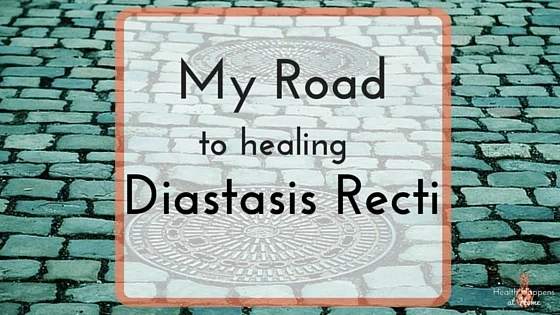This post contains affiliate links. Learn more here and thanks for your support! Read my follow up post about my continuted journey here.
In August of 2014, I joined a stroller mom workout group. I was loving the fellowship, accountability and fun, but I started having pain around my belly button during workouts. I also had severe back pain when trying to babywear. So I Googled it to come up with some possible reasons. My husband hates it when I use internet to self diagnosis - but I find it's usually effective! I figured out that I had diastasis recti, which is apparently very common after pregnancies but, my third child was already about 11 months old! Shouldn't I have recovered fully from the pregnancy and birth? As you can probably guess, I took lots of prenatal and women's classes leading up to the births of each of my children and I had never heard of diastasis recti before. Knowing what I know now, it should be at least mentioned as something to look out for.
What is Diastasis Recti?
Diastasis recti is the separation of your abdominal muscles (rectus abdominis - 6 pack muscles) and weakness in the connective tissue between these two groups of muscles. In many women this results in the "mommy tummy" pooch where you still appear pregnant even though the "baby" can be several years old. Other symptoms may include lower back pain, pelvic floor weakness, urine leakage, abdominal pain, breathing difficulties, constipation, hernia, poor posture.
I did not have a pooch in my stomach, which is usually the classic symptom. I did have pain around my belly button, severe lower back pain, pelvic floor weakness despite lots of kegal exercises. I started having serious pain when attempting planks with my workout group and my abdominals seemed to get weaker when doing crunches.
What causes Diastasis Recti?
It is the result of too much intra-abdominal pressure. It usually stems from poor body alignment and posture combined with events that cause excessive force. Some examples of excessive force events are: pregnancy, especially more than one pregnancy or carrying more than one baby, excessive and/or very difficult pushing in child birth, rapid weight change, doing sit-ups, improper weight lifting, etc. So diastasis recti can actually occur in men, too!
I started having pelvic floor weakness and urine leakage while pregnant with my third child. I also had an an extended and difficult time pushing during labor with her. Also, I have spent most of my life in inappropriate shoes. For example, flipflops during my lifeguarding years and shoes with heels the rest of the time. I'm only 5'3" so often I wore heels to appear taller or to prevent pants from dragging without paying to have them hemmed. I have since learned on my road to healing, these poor footwear choices likely have caused intra-abdominal pressure and poor posture contributing to my diastasis recti.
The Road to Healing
First, my wonderful instructors in the stroller group were happy to adapt the exercises to protect my core. When our schedule changed for summer and my older kids were no longer in preschool during the day, I decided to take a break for the stroller group (it was tough to push and entertain 3 kids) and focus on healing my core. I did lots of internet research and even attempted a free video online. Unfortunately, that lead to severe sciatica pain because I was not isolating the correct muscle groups. I finally decided on the MUTU System. A 12 week program with online coaching and workout videos. I had printed some random exercises from the internet, but I've found the accountability and ease of videos (or live classes) to be essential for me to stick with a workout system. The MUTU videos are also downloadable and there is no expiration date for the web content! Once I purchased the program, I also was able to join the Facebook support group which has also proven to be a valuable source of information and support! Wendy Powell, the creator of MUTU and a British mom of two, also addresses proper body alignment, footwear and even has a video with a guided relaxation to combat stress. MUTU System incorporates strength, cardio, and flexibility.
How to Know if You Have Diastasis Recti?
Here is a video of a quick and easy test you can do at home. Doctors, physical therapists and other health care practitioners can also measure for diastasis recti. Since diastasis recti is usually measured in finger widths, it can be a bit subjective.
At the time of self-diagnosis I had about a 3 finger gap with very weak connective tissue. When I completed the 12 week MUTU System I had a 2 finger gap with strong connective tissue. I recently resumed some more intense exercise (the Firm Zip Trainer DVD's) and pelvic floor issues and lower back pain have resumed. So it's back to the MUTU workouts for me. I plan to get the MUTU app soon. Only $8.99 for over a million workouts! No subscriptions or monthly fees! (Update: read my review of the MuTu app here.)
The MUTU System has proven to be an effective and enjoyable tool to healing my diastasis recti! I've decided to become a MUTU affiliate to help others suffering from diastasis recti find this great system to get on the road to recovery. Similar to all my affiliate partnerships, if you purchase the MUTU System through links on this site your price doesn't change and I receive a small commission. Thanks so much for supporting this site so I can bring you great content!
For more information check out some related posts from around the web:
http://www.parents.com/pregnancy/my-body/postpartum/diastasis-recti/
http://inspiredrd.com/2012/06/dear-diastasis-recti-im-so-over-you/
http://diastasisrectified.com/
Here is an Amazon affiliate link to equipment I used completing the MUTU System. Wendy uses a Ugi ball which looks awesome but is quite expensive. The Zip Trainer below works great for these exercises.
Thanks for reading! If you are suffering from diastasis recti, I hope you find healing!
Health really does happen at home,
Erin Marie













The journey continues, more on diastasis recti and my review of the MuTu app.